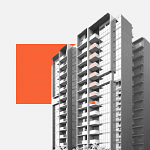Rise in private home prices eases in Q1, up 0.8% as market finds new equilibrium
Price growth moderates from 2.3% increase in previous quarter, even as brisk home buying continues

[SINGAPORE] The private housing market in Singapore appears to be settling at a new equilibrium, with prices stabilising even as buying momentum continued, analysts said.
Figures released by the Urban Redevelopment Authority (URA) on Friday (Apr 25) showed that the prices of private residential properties rose 0.8 per cent in the first quarter of 2025. This was a tad higher than the 0.6 per cent flash estimate by the agency earlier this month, and eases from a 2.3 per cent increase in the previous quarter.
In fact, price growth moderated across the board in Q1, save for landed homes, noted PropNex chief executive officer Ismail Gafoor. Prices of landed properties rose 0.4 per cent in the quarter, reversing from a 0.1 per cent decline in the quarter before.
Meanwhile, that of non-landed properties was up 1 per cent in Q1, versus the 3 per cent growth in the fourth quarter.
By region, prices in the city fringe or Rest of Central Region (RCR) grew the most – by 1.7 per cent. This was followed by the prime Core Central Region (CCR) with a 0.8 per cent growth, and the suburbs or Outside Central Region (OCR) with 0.3 per cent.
In comparison, prices in the three regions increased by 2.6 to 3.3 per cent in Q4 last year.
A NEWSLETTER FOR YOU

Tuesday, 12 pm
Property Insights
Get an exclusive analysis of real estate and property news in Singapore and beyond.
The moderation in price growth came even as buying demand remained strong, particularly in the OCR with strong take-up rates at several newly launched projects, said Leonard Tay, Knight Frank head of research.
For instance, Lentor Central Residences had a take-up rate of 93 per cent, selling 445 out of 477 units. This was 87 per cent at the 1,193-unit Parktown Residence in Tampines, 65 per cent at the 501-unit Elta in Clementi, and 61 per cent at the 113-unit Bagnall Haus in East Coast.
Lee Sze Teck, senior director of data analytics at Huttons Asia, attributed the smaller gains in prices to a higher proportion of new sales in the OCR in the quarter. Such deals, which tend to have lower quantums, accounted for 66.3 per cent of all transactions in Q1, compared to 41.7 per cent in Q4.
Buying also remained brisk amid lower interest rates, a positive economic outlook, tight employment market and healthy household balance sheets, added Lee.
New home sales therefore held fairly firm with 3,375 units sold in Q1. While it was down slightly from Q4’s 3,420 units, it was nearly treble of Q1 2024’s 1,164 units.
It was also the second-highest quarterly new sales figure recorded in the last three years, with the peak occurring in Q4 2024, said OrangeTee Group chief researcher and strategist Christine Sun.
At the same time, developers launched 3,139 units for sale in the quarter, a shade lower than the 3,425 units put on the market in Q4.
Unsold inventory of uncompleted private homes, excluding executive condominiums (ECs), consequently fell 6.6 per cent to 18,125 units in the quarter, from 19,405 units in the quarter before, said Tricia Song, CBRE head of research for South-east Asia.
Including completed units, this figure was down 6.8 per cent to 18,270 units in Q1 – significantly lower than the previous peak of 37,799 units recorded in Q1 2019, noted Song.
This could be cleared in under three years, based on the five-year annual average for new home sales from 2020 to 2024, at 8,600 units, and 2024’s total developer sales of 6,469 units, she added.
In the resale market, there were 3,565 resale transactions in Q1, compared with 3,702 units transacted in the prior quarter. These deals accounted for 49.1 per cent of all sales transactions in Q1, slightly lower than the 49.8 per cent in Q4.
URA data also showed that rents of private homes rose 0.4 per cent in Q1, after staying flat in the prior quarter. The vacancy rate inched down to 6.5 per cent as at end-Q1, from 6.6 per cent in Q4.
Knight Frank’s Tay noted that a higher proportion of vacant inventory remained among smaller units, such as one or two-bedroom flats. Thus, “landlords of smaller units may need to adjust their rental expectations in order to keep their assets occupied,” he added.
With demand and supply now in balance in the leasing market, Tay reckoned that rental growth will moderate between 1 per cent and 3 per cent in 2025, supported by “renewals at large and continued interest in family-sized inventory”.
Meanwhile, analysts are cautiously optimistic on the overall private housing market.
Despite escalating trade tensions and market volatility, which could dampen sentiment, ERA chief executive Marcus Chu believes Singapore’s property market remains resilient. This is mainly since it is supported by domestic buyers with mid- to long-term outlooks, keeping activity rooted in “genuine demand rather than speculation”.
In the remaining three quarters of 2025, 5,187 private homes, including ECs, are set to be ready. These include units with and without planning approval. Another 7,968 units are expected to be completed in 2026, and 11,170 in 2027.
Up to 15 new condo projects and two EC projects are likely to launch in the rest of 2025, yielding around 7,800 homes, Chu added.
But since most will be in the CCR and RCR, which have higher prices and may not generate the same kinds of volumes, Song predicts that new home sales for the year may slow to 7,000 to 8,000 units, with prices growing 3 to 4 per cent.
Copyright SPH Media. All rights reserved.



